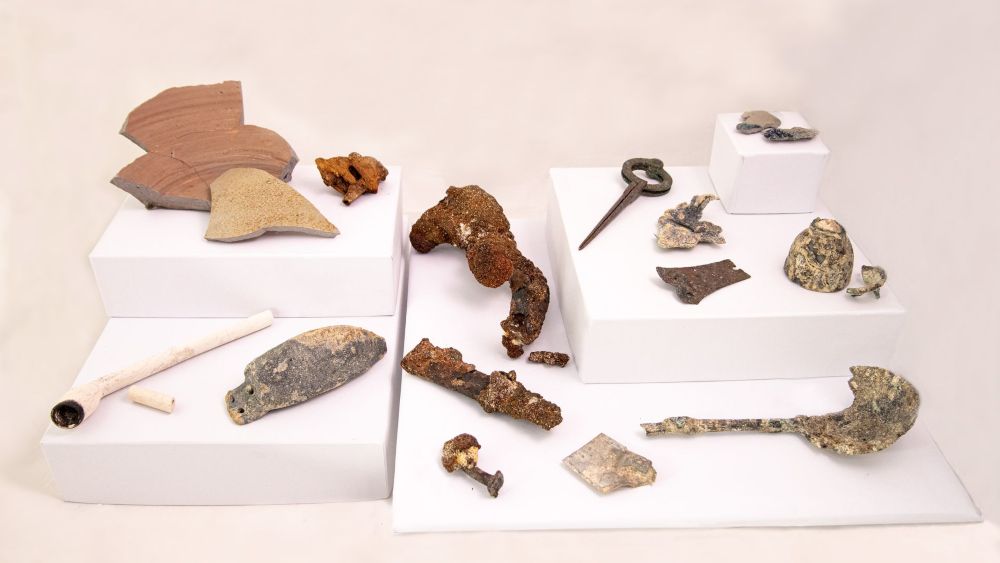The wreck of the VOC ship Vergulde Draeck (Gilt Dragon) in 1656 is one of the most enduring mysteries of early Dutch contact with Australia. While the wreck site was rediscovered in 1963, the fate of the seventy-five survivors who reached the shore has never been conclusively known. Recent archaeological discoveries along the Western Australian coast now suggest that the long-lost survivors’ camp may finally have been located.
The loss of the Vergulde Draeck in 1656
The Vergulde Draeck departed the Netherlands in October 1655 on its way to Batavia, carrying trade goods, supplies and 193 people. On 28 April 1656 the ship was wrecked on a reef near present-day Ledge Point, about one hundred kilometres north of Perth. Seventy-five men made it ashore, salvaging a small number of tools, weapons and provisions.
A small crew of seven then attempted the impossible: to sail the ship’s boat from Western Australia to Batavia to seek help. Remarkably they succeeded after forty days at sea. Their voyage prompted the VOC to send out three rescue missions between 1656 and 1658, but none were able to find the castaways. Smoke, footprints and possible shelters were noted by the search parties, yet all attempts to locate the group failed. No trace of the survivors was ever confirmed.
Early clues and the long search
For centuries the question of where the survivors lived, and how long they endured, has animated explorers, researchers and maritime archaeologists. Reports over the nineteenth and twentieth centuries mentioned isolated finds of Dutch clay pipes, ceramics and small metal tools along the coast, but most lacked archaeological context and could not be linked definitively to the Vergulde Draeck.
The search continued without firm conclusions. Unlike the well-documented survivor camps of the Batavia wreck on Beacon Island, the location of the Vergulde Draeck castaways remained a missing chapter in the Dutch experience on the Australian continent.
A breakthrough discovery
The search took a significant turn in 2023, when a private metal-detector enthusiast discovered several seventeenth-century objects on a remote stretch of the Western Australian coast and handed them to the Western Australian Maritime Museum in Fremantle. The finds included fragments of Dutch ceramics, a brass navigation divider, a bronze clasp and a lead fishing weight. These artefacts closely matched items previously recovered from the wreck site.
In 2024 and 2025 the museum undertook controlled surveys and excavations at the location. Archaeologists uncovered additional objects, including an intact seventeenth-century clay pipe, more Dutch ceramics and several small metal fittings. Every item was carefully recorded, allowing precise comparison with known materials from the shipwreck.
According to museum director Alec Coles, the find is of major significance for the region’s maritime history. He noted that sites like this offer valuable insights into the fate of people who survived early European shipwrecks on the Australian coast and how they adapted to unfamiliar and harsh environments. The site has now been granted protected status under Western Australian heritage law, ensuring that any future research occurs under archaeological supervision.

Why these finds matter
The assemblage discovered at the site is coherent and consistent with the type of domestic, navigational and fishing items that shipwreck survivors would likely have carried ashore. Unlike earlier isolated finds, this collection appears to come from a single historical context and represents the strongest evidence to date of a Vergulde Draeck survivor camp.
If confirmed, this location would be the first known survivor camp from a Dutch VOC shipwreck on the Australian mainland. It offers the possibility of understanding how the survivors organised their lives, what materials they salvaged from the wreck, and how they attempted to sustain themselves while waiting for a rescue that never came. It may also provide clues about whether there was any contact between the castaways and Indigenous Noongar communities.
An important contribution to Dutch–Australian heritage
The story of the Vergulde Draeck stands alongside the wrecks of the Batavia, Zuytdorp and Zeewijk as foundational episodes in Australia’s early maritime history. These events highlight that Dutch presence on the Australian shore predates British colonisation by more than a century and a half.
The recent discoveries strengthen the historical link between the Netherlands and Australia, reminding us that the coast of Western Australia was a stage for encounters, survival attempts and exchanges long before European settlement. For the Dutch Australian community, this emerging evidence provides a poignant connection to the men who endured hardship on a remote shore, and whose fate has remained one of the great mysteries of the VOC era.
The Western Australian Museum plans to exhibit the newly recovered objects, giving the public the opportunity to see these remarkable traces of a nearly forgotten story. As research continues, the findings may help close one of the oldest gaps in the shared maritime heritage of the Netherlands and Australia.


